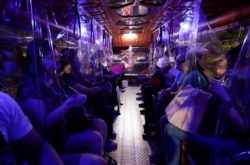Confirmed coronavirus infections in the Philippines soared past 50,000 on Wednesday in a troubling milestone for a country that has reopened an economy on the brink of recession while still struggling to combat the pandemic.
The Department of Health reported 2,539 new cases, bringing the country's total to 50,359, including 1,314 deaths. The Philippines' caseload is the second largest in Southeast Asia, where the combined number of infections has surpassed those in China, where the pandemic emerged.
President Rodrigo Duterte eased a tough virus lockdown in the Philippine capital of more than 12 million people on June 1 after the economy shrank slightly in the first quarter, its first contraction in more than two decades. The downturn may be worse in the second quarter and usher in a recession, economic officials said.
Indonesia, hardest hit by the pandemic in the region, has also walked a tightrope by resuming business activities last month despite continuing spikes in infections.
"I think we have no alternative but to really reopen the economy," presidential spokesman Harry Roque said. "If we still can't reopen, maybe we'll stay alive but eventually die because we have no jobs. We're looking at the balance."
Duterte suggested in remarks broadcast on Wednesday that he will be careful in further relaxing coronavirus restrictions, saying he could not be as bold as U.S. President Donald Trump and Brazilian President Jair Bolsonaro.
Bolsonaro, who at times downplayed the risk posed by COVID-19, announced Tuesday that he has tested positive for the virus. Brazil currently has the second largest number of infections in the world after the United States.
"I'm sorry but I cannot really ... remove the leash," Duterte said on TV, adding that if he allowed massive numbers of people back into the streets, the result might be "too horrible to ponder."
The Philippines has been particularly battered as a leading source of global labor.
Aside from massive domestic job losses due to quarantine restrictions and business closures, the Philippines has scrambled to deal with tens of thousands of Filipinos who have flown home after losing overseas jobs.
Authorities shut Manila's international airport for a week in May to allow time to decongest quarantine centers in the capital which have been overwhelmed by more than 24,000 returned workers. Dozens of cruise ships have anchored in Manila Bay and waited for weeks or months for their thousands of Filipino crew to be tested before they were allowed by Philippine authorities to disembark.
Finding the balance between public health and reviving the economy has been fraught with dilemmas.
Officials acknowledge that the rising number of infections is a red flag but say it does not currently pose a high risk to a gradual resumption of economic activities if people follow mandatory health safeguards, including wearing face masks and social distancing.
Nearly 800,000 people have been tested for the virus so far and about 7% were found to have been infected, officials said.
Experts and even some of Duterte's political allies have called for more testing and tracking of people who may have been exposed to the virus for a clearer picture of the outbreak.
When Duterte eased the three-month lockdown that shuttered most government offices and businesses and halted public transport in the capital last month, thousands of workers were stranded because of the limited numbers of buses allowed back on the streets.
"It's been really difficult and confusing, especially for poor people like me," said Abraham Ramos, a 36-year-old cargo carrier in a public market who walks to work because of the lack of public transport.
Ramos was laid off from a paint factory in March as the outbreak intensified. When the lockdown was eased in June, he found work in the market but was accosted by law enforcers on Wednesday because he took off his face mask while drinking water in violation of quarantine rules.
Ramos was required to attend a public health lecture as punishment, which he said cost him a day's income.
"I just hope this will not last for a lifetime," Ramos said while being held with dozens of other quarantine violators.







